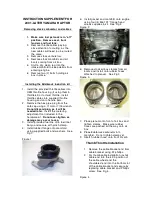
27
Wheels and Tyres
Wheels
The ventilated steel disc wheels are secured by five nuts. All nuts have right hand threads.
Tyres
The tyres fitted are 6.70 x 15 Dunlop Road Speed (RS5). These are tubed tyres having a nylon
carcase, and suitable for sustained speeds of up to 110 m.p.h. at standard pressures. Development
work on tyres is always proceeding, and Jensen Motors Limited will be pleased to give their latest
recommendations when new tyres are required.
Tyre Pressures
The recommended tyre pressures are :
Front 24 p.s.i. (1.7 Kg/cm2)
Rear 24 p.s.i. (22 p.s.i. for town use only)
For sustained speeds in excess of 110 m.p.h., the tyre pressures, front and rear, should be
increased to 30 p.s.i. (2.1 Kg/cm2)
Tyre and Wheel Balance
Tyre and wheel assemblies are balanced both statically and dynamically before they are fitted to the
car. In view of the high speeds attainable it is recommended that wheel balance is checked every
5,000 miles. Most large garages and service stations have balancing equipment.
Tyre Life
It is not recommended that the tyres be interchanged between front and back. (A tyre weakened by
excessive wheelspin could prove dangerous were it to fail when fitted to the front). However,
changing tyres from left to right and vice versa will help to prolong tyre life. If desired, the spare
can be alternated between the rear wheels.
The following factors have an adverse effect on tyre life :
1)
Incorrect tyre pressures.
2)
Misalignment of wheels.
3)
Harsh acceleration. Wheel spin should be avoided.
4)
Fierce braking.
Wheel Changing and Jacking System
The jacking system allows the car to be raised with the minimum of effort. The jack is of the Bevelift
type and is carried in the tool compartment, in the left hand side of the boot.
Four jacking holes are provided. These are in the chassis side members close to the wheel arches
and are protected by rubber plugs. These plugs have retaining wires to prevent them being lost.
When it is necessary to change a wheel the following procedure should be adopted.
1)
The car should be on a hard level surface.
2)
The handbrake should be applied.
3)
The nave plates should be removed using the screwdriver in the tool kit. To avoid the
possibility of damage to the nave plate, it should be levered off as close as possible to one
of the retaining studs. These are located at 3 o/c, 7 o/c and 11 o/c relative to the tyre valve.
4)
The wheel nuts should be slightly loosened, but not removed, using the wheelbrace
provided.
5)
The spare wheel should be removed from its bracket (see Spare Wheel stowage page ).
6)
The rubber plug should be removed from the nearest jacking point, and the jack spigot
inserted. The handle should be turned clockwise to raise the car.
7)
When the wheel is well clear of the ground the wheel nuts should be removed, and the
wheels changed over.
The procedure should then be reversed.















































